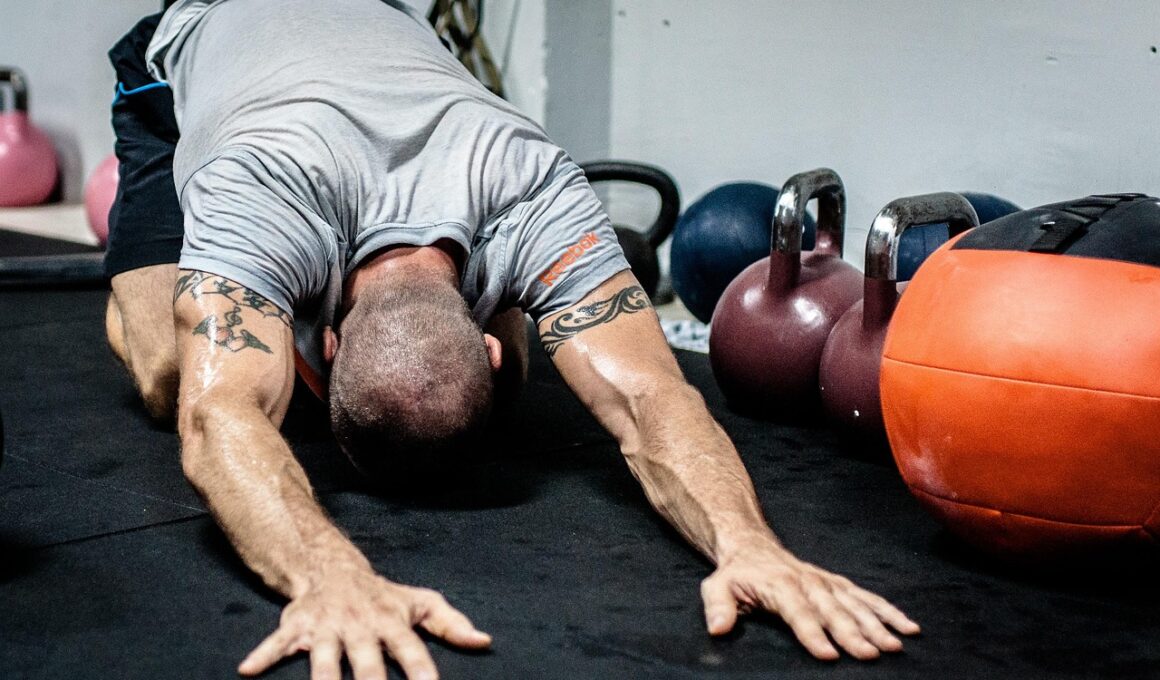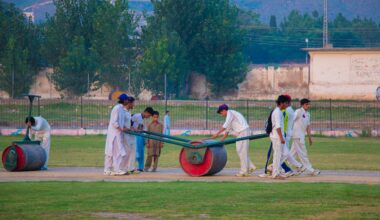The Connection Between Kettlebell Training and Post-Workout Stretching
Kettlebell training is a versatile approach to building strength, endurance, and flexibility, enhancing overall fitness levels effectively. While kettlebell workouts are impactful, the significance of post-workout stretching should not be overlooked. Incorporating dynamic stretching throughout the training session prepares the muscles for the workout, while static stretching during the cool-down phase promotes recovery. Stretching helps alleviate the intense tension built up during exercises by elongating the muscles used. By focusing on breathing techniques along with each stretch, the body can release tension and promote relaxation. Various stretches target specific muscle groups engaged in kettlebell training, ensuring a well-rounded approach to recovery. For those engaging in kettlebell routines frequently, maintaining flexibility is vital to preventing injuries. Not only does stretching help in muscle recovery, but it also enhances performance in future workouts. Moreover, practitioners often notice improved range of motion in subsequent sessions. In elaborating on kettlebell training’s benefits, it’s essential to recognize the integral role of effective stretching in optimizing the complete experience and outcomes of workouts. Including a dedicated cool-down routine elevates fitness journeys and exemplifies a holistic approach to health.
One of the primary advantages of post-workout stretching is that it mitigates muscle soreness known as delayed onset muscle soreness (DOMS). Experiencing DOMS after kettlebell workouts is common, especially when performing high-intensity lifting or when introducing new exercises into your routine. By integrating static stretches aimed at the major muscle groups involved in kettlebell training, one can facilitate blood flow to tired muscles, aiding in the breakdown of lactic acid. This not only helps in easing discomfort but also promotes improved mobility for the next training session. Flexibility through stretching plays a pivotal role in ensuring effective kettlebell movements by allowing a full range of motion. A greater range of motion enhances performance, allowing for more explosive movements and providing stability during challenging exercises. Furthermore, stretching has mental benefits as well. The act of stretching can be a meditative practice that promotes mental relaxation after a strenuous workout. Focusing on breath during stretches provides a moment of mindfulness, helping to disconnect from the intensity of the workout. Introducing a routine focused on recovery can transform the approach to fitness and ensure longevity in a kettlebell training regimen.
The Importance of a Structured Cool-Down Routine
Developing a structured cool-down routine post-kettlebell training is essential, significantly impacting the body’s recovery and performance. After an intense workout, the body craves restoration; stretching assists in achieving this balance. Effective cool-down routines that incorporate stretching can include exercises like hamstring stretches, quadriceps stretches, and shoulder stretches, targeting key areas engaged during kettlebell routines. These exercises help gradually return the heart rate to its resting state, reducing the risk of light-headedness and fatigue. The duration and quality of each stretch matter, as holding stretches for 15 to 30 seconds is recommended for maximum benefit. In addition to muscle recovery, a proper cool-down significantly improves flexibility, which can directly influence kettlebell performance. Enhanced flexibility encourages safer movement patterns, ultimately reducing the risk of injury as one progresses in their kettlebell journey. Engaging in gentle movements combined with stretches promotes greater muscle lengthening, ensuring muscle fibers have the opportunity to relax and recover. Establishing and adhering to a cool-down routine will be fundamental for anyone seeking to maximize their kettlebell experiences, enabling them to train more effectively and prevent injuries.
The mental aspect of kettlebell training extends into the cool-down phase as well. Utilizing this time to practice mindfulness through stretching can be profoundly beneficial. This practice allows practitioners to reflect on their workout, fostering a deeper connection with their body and its capabilities. Emphasizing the importance of mental recovery, practitioners can assess their progress, set future goals, and understand the impact of workouts on personal growth. Certain stretches can also serve as an excellent opportunity to focus on breathing techniques, leading to improved oxygen flow within the body. Higher oxygen levels during recovery allow the body to clear out toxins and lactic acid more effectively, enhancing overall recovery. Additionally, visualization techniques can be employed during the cool-down, helping practitioners to envision their progress and future workouts. The performing of stretches becomes not only a physical practice but also a mental one, crucial for achieving balance in fitness. The connection between mind and body strengthens as one settles into each stretch. By considering both aspects, individuals ensure that their kettlebell training remains safe, efficient, and beneficial, encompassing the comprehensive goals set in their fitness journey.
Best Stretches for Kettlebell Training
Many effective stretches complement kettlebell training and support recovery. Each stretch targets specific muscles utilized during workouts. First, the cat-cow stretch promotes back mobility and eases tension in the spine after intense training. Next, the standing quadriceps stretch effectively targets the front thighs, which are heavily engaged during kettlebell squats and deadlifts. Further, deep lunging hip flexor stretches relieve tightness in the hips, essential for proper kettlebell form. Shoulder stretches also play an important role in maintaining flexibility across the upper body since kettlebell swings and snatches require robust shoulder engagement. Incorporating seated or standing forward bends into the routine benefits the hamstrings, where stiffness often accumulates during kettlebell training. Additionally, the figure-four stretch can alleviate tension in the glutes, allowing for greater motion and reducing strain during kettlebell movements. There’s also the butterfly stretch, which significantly opens the hips. By diversifying stretching techniques, one ensures a holistic approach to recovery. Engaging in these targeted stretches consistently allows practitioners to maintain flexibility, improve mobility, and prevent potential injuries efficiently, enhancing overall kettlebell training outcomes.
Incorporating post-workout stretching should be a non-negotiable aspect of every kettlebell training regimen. By recognizing the numerous benefits associated with adequately stretching after a workout, practitioners will experience a significant improvement in their overall wellness journey. Establishing a structured cool-down routine is essential for maintaining flexibility and joint health. Strong flexibility not only supports strength training but also enhances overall performance in kettlebell movements. Moreover, developing a habit of stretching encourages self-care and promotes a balanced approach to fitness. Addressing recovery emphasizes the importance of respect for the body, ensuring maximum enjoyment during workouts. As individuals become more attuned to their bodies through regular stretching practices, they foster a deeper appreciation for their kettlebell training journeys. Additionally, stretching becomes a tool for mindfulness, contributing to mental well-being as one reflects on their fitness journey. By integrating various stretches into post-workout routines consistently, practitioners nurture their bodies, enabling them to engage more incredibly with kettlebell workouts. The culmination of physical and mental benefits promotes resilience and long-term commitment, paving the way for a healthier lifestyle. Ultimately, dedicated recovery through stretching is paramount to maximizing results achieved through kettlebell training.
Conclusion: Prioritizing Recovery for Success
Prioritizing recovery through stretching significantly amplifies the benefits derived from kettlebell training. Enhancing flexibility, alleviating post-workout soreness, and supporting mental health are just some of the many perks of a consistent cool-down routine. Moreover, implementing effective stretches positively influences performance, ensuring that kettlebell workouts remain progressive and beneficial. As individuals strive to better themselves through fitness, recognizing the interconnectedness of strength training and recovery becomes crucial. A fundamental commitment to recovery practices like stretching reflects wisdom in one’s training philosophy, appreciating the journey towards physical and mental well-being. By embracing the importance of post-workout recovery, individuals cultivate an environment that fosters continuous improvement. Taking the time to cool down assists in instinctively tuning into one’s body, optimizing performance outcomes. Practitioners can navigate through their kettlebell routines equipped with the knowledge that recovery is integral and not an afterthought. Gradually establishing stretching as a key component of fitness routines will yield lasting results in strength, endurance, and flexibility. Through dedicated practice, enthusiasts create a foundation for lifelong kettlebell training success and improved overall fitness.
In conclusion, the interplay between kettlebell training and post-workout stretching is dynamic and urgent. Transitioning from high-intensity workouts to recovery phases is vital for long-term fitness progress. Comprehensive knowledge about the types of stretches that provide the most effective recovery will be invaluable for anyone engaged in kettlebell training. Focusing on nourishing the muscles post-workout as well as enhancing flexibility and mental equanimity must be pursued. A successful kettlebell training program encompasses both the strong and the supple; intelligently written cooldown can prepare the body to thrive. Recovery is not merely about rest, but ensuring that the body is equipped to return stronger and more resilient for the next session. Building habits centered around stretching promotes a holistic approach to fitness and reduces the risk of injury. Cultivating discipline in training and recovery elevates personal fitness journeys. When practitioners pay attention to both their kettlebell workouts and their cool-down sessions, they’ll achieve balanced development. Ultimately, investing time in recovery and stretching yields rewards that significantly enhance kettlebell training outcomes, promoting a sustainable and enjoyable fitness lifestyle that lasts.


